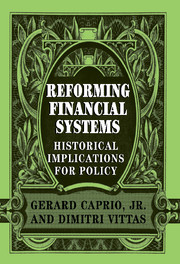Book contents
- Frontmatter
- Contents
- List of contributors
- Foreword
- 1 Financial history: Lessons of the past for reformers of the present
- 2 The evolution of central banking
- 3 Free banking: The Scottish experience as a model for emerging economies
- 4 Regulation and bank stability: Canada and the United States, 1870–1980
- 5 Deposit insurance
- 6 Contingent liability in banking: Useful policy for developing countries?
- 7 Universal banking and the financing of industrial development
- 8 Before main banks: A selective historical overview of Japan's prewar financial system
- 9 Thrift deposit institutions in Europe and the United States
- 10 The development of industrial pensions in the United States during the twentieth century
- 11 The rise of securities markets: What can government do?
- Index
4 - Regulation and bank stability: Canada and the United States, 1870–1980
Published online by Cambridge University Press: 25 March 2010
- Frontmatter
- Contents
- List of contributors
- Foreword
- 1 Financial history: Lessons of the past for reformers of the present
- 2 The evolution of central banking
- 3 Free banking: The Scottish experience as a model for emerging economies
- 4 Regulation and bank stability: Canada and the United States, 1870–1980
- 5 Deposit insurance
- 6 Contingent liability in banking: Useful policy for developing countries?
- 7 Universal banking and the financing of industrial development
- 8 Before main banks: A selective historical overview of Japan's prewar financial system
- 9 Thrift deposit institutions in Europe and the United States
- 10 The development of industrial pensions in the United States during the twentieth century
- 11 The rise of securities markets: What can government do?
- Index
Summary
This chapter compares the banking systems in Canada and the United States between 1870 and 1980. The comparison is interesting to policy makers, economic historians, and macroeconomists because it presents two countries that have much in common – comparable levels of economic development and similar cultural, political, and social traditions. But although Canada and the United States are probably as similar as any two countries in the world, one important difference persists: they have and always have had very different banking systems.
Throughout its history the United States has had, by and large, a unit banking system. True, many states allow branch banking or limited branch banking. But until 1994, when the U.S. Congress removed the prohibitions on interstate branch banking, the practice was prohibited nationwide and within many states. This prohibition led to a system characterized by a large number of small banks. In 1990 there were about 12,000 banks, perhaps the largest number of any country, and there were as many as 30,000 banks in the early part of the century.
Compare this system with that of Canada. Canada is a much smaller country – approximately one-tenth or one-eleventh the size of the United States in every dimension (except geographically). And Canada has always had unlimited branching. As a result a small number of very large nationwide banks emerged in this century. From 1920 until 1980 there were approximately eleven. But other differences persist as well. The countries' regulatory systems differ: the United States has had a long tradition of reserve requirements, whereas Canada did not mandate these until the 1930s.
- Type
- Chapter
- Information
- Reforming Financial SystemsHistorical Implications for Policy, pp. 65 - 84Publisher: Cambridge University PressPrint publication year: 1997
- 2
- Cited by



